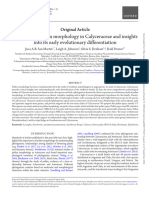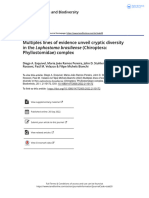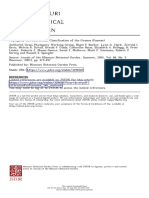0 ratings0% found this document useful (0 votes)
321 viewsNew Cattleyas
New Cattleyas
Uploaded by
Wesley Higgins1) The taxonomy of Cattleya has been problematic since its inception in 1821 due to similarities with other genera like Sophronitis. Molecular studies in the late 20th century helped resolve relationships within the Cattleya alliance.
2) A recent combined study of nuclear and chloroplast DNA indicates that Sophronitis s.l. is embedded among Cattleya, supporting the lumping of these genera. Cattleya now includes 117 species.
3) Genera no longer considered part of Cattleya include Guarianthe, Laelia sensu stricto, and Rhyncholaelia. The article summarizes changes in circumscription and classification of Cattleya.
Copyright:
Attribution Non-Commercial (BY-NC)
Available Formats
Download as PDF, TXT or read online from Scribd
New Cattleyas
New Cattleyas
Uploaded by
Wesley Higgins0 ratings0% found this document useful (0 votes)
321 views2 pages1) The taxonomy of Cattleya has been problematic since its inception in 1821 due to similarities with other genera like Sophronitis. Molecular studies in the late 20th century helped resolve relationships within the Cattleya alliance.
2) A recent combined study of nuclear and chloroplast DNA indicates that Sophronitis s.l. is embedded among Cattleya, supporting the lumping of these genera. Cattleya now includes 117 species.
3) Genera no longer considered part of Cattleya include Guarianthe, Laelia sensu stricto, and Rhyncholaelia. The article summarizes changes in circumscription and classification of Cattleya.
Copyright
© Attribution Non-Commercial (BY-NC)
Available Formats
PDF, TXT or read online from Scribd
Share this document
Did you find this document useful?
Is this content inappropriate?
1) The taxonomy of Cattleya has been problematic since its inception in 1821 due to similarities with other genera like Sophronitis. Molecular studies in the late 20th century helped resolve relationships within the Cattleya alliance.
2) A recent combined study of nuclear and chloroplast DNA indicates that Sophronitis s.l. is embedded among Cattleya, supporting the lumping of these genera. Cattleya now includes 117 species.
3) Genera no longer considered part of Cattleya include Guarianthe, Laelia sensu stricto, and Rhyncholaelia. The article summarizes changes in circumscription and classification of Cattleya.
Copyright:
Attribution Non-Commercial (BY-NC)
Available Formats
Download as PDF, TXT or read online from Scribd
Download as pdf or txt
0 ratings0% found this document useful (0 votes)
321 views2 pagesNew Cattleyas
New Cattleyas
Uploaded by
Wesley Higgins1) The taxonomy of Cattleya has been problematic since its inception in 1821 due to similarities with other genera like Sophronitis. Molecular studies in the late 20th century helped resolve relationships within the Cattleya alliance.
2) A recent combined study of nuclear and chloroplast DNA indicates that Sophronitis s.l. is embedded among Cattleya, supporting the lumping of these genera. Cattleya now includes 117 species.
3) Genera no longer considered part of Cattleya include Guarianthe, Laelia sensu stricto, and Rhyncholaelia. The article summarizes changes in circumscription and classification of Cattleya.
Copyright:
Attribution Non-Commercial (BY-NC)
Available Formats
Download as PDF, TXT or read online from Scribd
Download as pdf or txt
You are on page 1of 2
nomenclature notes
The New Cattleyas By Wesley Higgins and Cássio van den Berg
The Changing Face of an Alliance’s Classification
When John Lindley published
the genus Cattleya based on Cattleya
labiata (1821), he described it as “the
handsomest species of the order.” He then
added Cattleya loddigesii, followed by
Cattleya forbesii and Cattleya citrina to the
genus (1826). Cattleya1 citrina is currently
recognized as Prosthechea citrina. Thus
the circumscription of Cattleya has been
problematic since its inception.
Flower forms in many genera of
Laeliinae are similar to Cattleya, which
has created taxonomic confusion. There
have been numerous attempts to classify the
subtribe (van den Berg and Chase 2004).
In the closing decade of the last century,
molecular systematics began to play an im-
portant role in orchid taxonomy. As updated
classifications began to be published, many
plant breeders were not surprised, because
it was already evident that Encyclia and
Prosthechea did not breed the same and
that Brazilian laelias were different from
Mexican laelias, etc.
When van den Berg et al. (2000) pu-
blished internal transcribed spacers (ITS)
sequence data (nuclear DNA), it was shown
that the Brazilian species of Laelia did not
belong with the Mexican Laelia group of
species that included the type species of the
genus. The initial solution proposed was to
place the Brazilian species of Laelia into
Sophronitis (van den Berg and Chase 2000,
2001). However, other authors preferred to
split these species into several segregate ge-
nera (Chiron and Castro Neto 2002). Both
of these approaches created havoc in hybrid
nomenclature as numerous new nothoge-
nera (artificial genera) were published to
account for changing taxonomy.
1
In 2000, the relationships of Cattleya
remained unresolved despite using molecu-
Because Cattleya, as previously cir- [1] Cattleya labiata, the type species of Cat-
lar systematics. More recent DNA studies
cumscribed, is paraphyletic to Sophronitis tleya that John Lindley named in honor of
of Laeliinae are better resolved with the use
s.l., it would require the creation of many William Cattley. This plate, from Collecta-
of nine plastid regions (chloroplast DNA)
(van den Berg et al. 2009) plus the original new genera for the various subgroups of nea Botanica (1821), is a hand-colored
ITS data set (van den Berg et al. 2000). This Cattleya thus requiring new nothogenera engraving based on a drawing by Lindley.
combined study indicates that even though for hybrids. A more practical (and simp-
Sophronitis senso lato is always present, the ler) solution is to lump all Sophronitis s.l. den Berg (2008) has renamed the other
relationships among this group (Cattleya, species with Cattleya and classify these species. In summary, Cattleya now has 117
Brassavola and Sophronitis) are different groupings at the infrageneric level (subge- recognized species, subspecies or varieties
from those produced with the ITS data set nus, etc.). In this way, future infrageneric and 40 natural hybrids. A review of Cattleya
alone. Sophronitis s.l. is embedded among changes would not require further binomial infrageneric taxonomy will be published in
species traditionally recognized as Cat- changes, providing also nomenclatural a future article.
tleya, whereas Brassavola is placed outside stability for artificial hybrids of species in Thus the question arises, “What is
the Cattleya–Sophronitis clade. this alliance. Some species of the former not included in the new Cattleya?” The
Brazilian Laelia and Sophronitis had ori- short answer is Guarianthe, Laelia sensu
1
Formerly Euchile. ginally been placed in Cattleya and van stricto (Mexico to Tropical America) and
344 Orchids june 2010 www.AOS.org
Rhyncholaelia. The genus Schomburgkia
has gone away with some species being
transferred into Myrmecophila and the rest
grouping with Laelia. Rhyncholaelia2 dig-
byana was also once classified as Cattleya
digbyana. Hybridization could have played
a significant role in the evolution of the
Cattleya alliance before the early diversi-
fication within each lineage. Guarianthe3
aurantiaca, Guarianthe 3 bowringiana,
Guarianthe3 patinii, Guarianthe3 skinneri
and Guarianthe3 ×guatemalensis (auranti-
aca × skinneri) are not part of the Cattleya
clade, but the assemblage only has weak
support as an independent group. In some
analyses, Cattleya maxima and Cattleya
araguaiensis are sister (adjacent) to Gua-
rianthe with weak support (van den Berg
et al. 2009). Hybrids can have a negative 2
effect on parsimony analysis (Huson and
Bryant 2006), creating false relationships. [2] Cattleya coccinea is illustrated as
The molecular studies of Laeliinae have Sophronitis grandiflora (Plate 161) in
revealed additional interesting data. Using Lindenia (1888). Lindenia — Iconographie
combined plastid and nuclear phylogenies des Orchidées was one of the important
in conjunction with mixed statistical infe-
periodic series on orchids published dur-
rence models (Bayesian), it is possible to
ing the 19th century.
recognize eight well-supported alliances
within Laeliinae, and make deductions
about biogeography, pollination system, Wesley E. Higgins, PhD, serves on the
and hybridization potential. Laeliinae IUCN-SSC Orchid Specialist Group. He
seems to have originated in Mexico and the is a member of the International Scientific
Caribbean, and primitive members seem Committee of Lankesteriana and a research
to have been originally pollinated by large associate at Centro de Investigación en Or-
bees, following dispersion to Central and quídeas de los Andes, Universidad Alfredo
South America and adaptive radiation due Pérez Guerrero, Ecuador. Higgins is also
to change in pollinator syndromes to birds, an accredited AOS judge, an approved AOS
butterflies, moths, wasps, and small bees taxonomic authority, and serves on the AOS
(van den Berg et al. 2009). Publications Committee, where he coordi-
nates the Nomenclature Notes column for
Orchids. 5317 Delano Court, Cape Coral,
References
Chiron, G.R., and V.P. Castro Neto. 2002. Revision des Florida 33904 (e-mail Higgins@alumni.
Espèces Brésiliennes du Genre Laelia Lindley. Rich- ufl.edu). Cássio van den Berg, PhD, gra-
ardiana 2:14–28. duated in agronomy from the University of
Huson, D., and D. Bryant. 2006. Application of Phylo-
genetic Networks in Evolutionary Studies. Molecular
São Paulo, and holds a master’s in ecology
Biology and Evolution 23(2):254–267. from the Universidade Estadual de Cam-
van den Berg, C. 2008. New Combinations in the Genus pinas and PhD in botany, University of
Cattleya Lindl. (Orchidaceae). Neodiversity 3:3–12.
Reading and the Royal Botanic Gardens,
— and M.W. Chase. 2000. Nomenclature Notes on
Laeliinae — I. Lindleyana 15(2):115–119. Kew. He is a professor in the Department
—. 2001. Nomenclature Notes on Laeliinae — II. Lind- of Biological Sciences at Universidade Es-
leyana 16(2):109–112. tadual de Feira de Santana. Van den Berg
—. 2004. A Chronological View of Laeliinae Taxonomical
History. Orchid Digest 68:226–254. has worked extensively on molecular and
—. 2005. Nomenclatural Notes on Laeliinae. IV. New morphological systematics of Laeliinae.
Combinations in Laelia and Sophronitis. Kew Bulletin Departamento de Ciências Biológicas,
59:565–567.
van den Berg, C., W.E. Higgins, R.L. Dressler, W.M.
Universidade Estadual de Feira de Santa-
Whitten, M. Soto Arenas and A. Culham. 2000. A Phy- na, BR116 KM3, 14 44031-460, Feira de
logenetic Analysis of Laeliinae (Orchidaceae) Based on Santana, Bahia, Brazil (e-mail vcassio@
Sequence Data from Internal Transcribed Spacers (ITS) gmx.de).
of Nuclear Ribosomal DNA. Lindleyana 15:96–114.
van den Berg, C., W.E. Higgins, R.L. Dressler, W.M. Whit-
ten, M. Soto Arenas and M. Chase. 2009. A Phylogenetic Manuscript submissions for Nomenclature
Study of Laeliinae (Orchidaceae) Based on Combined Notes should be sent to Higgins@alumni.
Nuclear and Plastid DNA Sequences. Annals of Botany
104(3):417–430.
ufl.edu.
World Checklist of Selected Plant Families. (2010). The
Board of Trustees of the Royal Botanic Gardens, Kew. 2
Formerly Brassavola.
http://www.kew.org/wcsp/. Accessed April 22, 2010. 3
Formerly Cattleya.
www.AOS.org june 2010 Orchids 345
You might also like
- Lab Activity No. 12 Phylogenetic SystematicsfDocument11 pagesLab Activity No. 12 Phylogenetic SystematicsfMelanie Mamon0% (1)
- Underline The Describing WordsDocument8 pagesUnderline The Describing WordsHammna Ashraf100% (2)
- Latin For Pharmacists PDFDocument143 pagesLatin For Pharmacists PDFIngaNo ratings yet
- Much, Many, A Few, A Little Worksheet: Esl / Efl ResourcesDocument1 pageMuch, Many, A Few, A Little Worksheet: Esl / Efl ResourcesSarah Carrillo50% (2)
- Hannah e Marx A Molecular Phylogeny and ClassificationDocument17 pagesHannah e Marx A Molecular Phylogeny and ClassificationSharesellaaccNo ratings yet
- American J of Botany - 2007 - Whitten - Molecular Phylogenetics of Maxillaria and Related Genera Orchidaceae CymbidieaeDocument30 pagesAmerican J of Botany - 2007 - Whitten - Molecular Phylogenetics of Maxillaria and Related Genera Orchidaceae Cymbidieaecaprichocanino2No ratings yet
- American J of Botany - 2002 - Nyffeler - Phylogenetic Relationships in The Cactus Family Cactaceae Based On Evidence FromDocument15 pagesAmerican J of Botany - 2002 - Nyffeler - Phylogenetic Relationships in The Cactus Family Cactaceae Based On Evidence FromDaniel Martínez QuezadaNo ratings yet
- Calvente 2011Document13 pagesCalvente 2011Hernán Ferrer PereiraNo ratings yet
- Nickrent 2010 TaxonDocument22 pagesNickrent 2010 TaxonAlexandre RodriguesNo ratings yet
- Phylogeny and Classification of Raninoida (Decapoda Brachyura)Document65 pagesPhylogeny and Classification of Raninoida (Decapoda Brachyura)عرڡاں حسروےNo ratings yet
- Mikkelsen, 2005Document83 pagesMikkelsen, 2005xicoalexandreNo ratings yet
- RenzagliaEtAl 2018 Hipótese Das Setaphyta e Antóceros Como Grupo IrmãoDocument8 pagesRenzagliaEtAl 2018 Hipótese Das Setaphyta e Antóceros Como Grupo IrmãoGeorge SidneyNo ratings yet
- This Content Downloaded From 186.84.90.196 On Mon, 25 Jan 2021 02:59:38 UTCDocument12 pagesThis Content Downloaded From 186.84.90.196 On Mon, 25 Jan 2021 02:59:38 UTCcarlos albeiro fonseca cruzNo ratings yet
- Cu-Noud - Et - Al-2002-American - Journal - of - Botany 1Document1 pageCu-Noud - Et - Al-2002-American - Journal - of - Botany 1BobNo ratings yet
- A Molecular Phylogeny of AnnelidsDocument23 pagesA Molecular Phylogeny of AnnelidsIsabella Maria Trujillo PulgarNo ratings yet
- Boae 068Document22 pagesBoae 068Virgi CortésNo ratings yet
- Molecular and Morphological Phylogenetics of Weevils PDFDocument25 pagesMolecular and Morphological Phylogenetics of Weevils PDFedliverNo ratings yet
- Cabrera Et Al. 2008 Araceae PhylogeneticsDocument13 pagesCabrera Et Al. 2008 Araceae PhylogeneticsGerardo A. SalazarNo ratings yet
- VazquezLobo AstroDocument10 pagesVazquezLobo AstroTit fuckerNo ratings yet
- 44014TH Sem Hons Cronquist S Classifcation - Merits DemeritsDocument3 pages44014TH Sem Hons Cronquist S Classifcation - Merits Demeritsshazeen shoaibNo ratings yet
- Red Algal TaxonomyDocument14 pagesRed Algal Taxonomydadette2009No ratings yet
- Kenneth J. Wurdack and Charles C. DavisDocument20 pagesKenneth J. Wurdack and Charles C. DavisAldo A. Vela0% (1)
- Basal Cactus Phylogeny - Implications of Pereskia (Cactaceae) Paraphyly For The Transition To The Cactus Life FormDocument13 pagesBasal Cactus Phylogeny - Implications of Pereskia (Cactaceae) Paraphyly For The Transition To The Cactus Life FormQueremosabarrabás A BarrabásNo ratings yet
- CupressusDocument14 pagesCupressusAllya GreenNo ratings yet
- 2017 3LietOlmsteadPhytotaxa3132222226 TwonewsubfamiliesDocument5 pages2017 3LietOlmsteadPhytotaxa3132222226 TwonewsubfamiliesSzilardNo ratings yet
- A Phylogeny of The Tropical Genus Piper Using ITSDocument15 pagesA Phylogeny of The Tropical Genus Piper Using ITSjlavilaNo ratings yet
- 2017 - Yañez Et. AlDocument18 pages2017 - Yañez Et. AlGugú YáñezNo ratings yet
- PK-216-001 Article-91032 en 1Document101 pagesPK-216-001 Article-91032 en 1Ricardo BressanNo ratings yet
- A Manual of Acarology. Third EditionDocument2 pagesA Manual of Acarology. Third EditionTejpal DahiyaNo ratings yet
- Hurtadoand DElia 2018 Taxonomyof GardnerycterisDocument18 pagesHurtadoand DElia 2018 Taxonomyof Gardnerycterisjose PomaNo ratings yet
- Pollen Morphology of Galactia P Browne and RelatedDocument18 pagesPollen Morphology of Galactia P Browne and Relatednm5588992No ratings yet
- Hernandez Et Al 2011 Phylogenetic Relationships and Evolution of Growth Form CactaceaeDocument18 pagesHernandez Et Al 2011 Phylogenetic Relationships and Evolution of Growth Form CactaceaeMatt SewellNo ratings yet
- Brasiliorchis A New Genus For The Maxillaria PictaDocument10 pagesBrasiliorchis A New Genus For The Maxillaria PictaJackie NunesNo ratings yet
- Fern Literature PDFDocument15 pagesFern Literature PDFDennis Nabor Muñoz, RN,RM100% (1)
- Denhametal CalyceraDocument25 pagesDenhametal Calycerahomies kunNo ratings yet
- Phylogeny of The BangiophycidaeDocument11 pagesPhylogeny of The Bangiophycidaedadette2009No ratings yet
- Algo de SiluridosDocument27 pagesAlgo de Siluridosrecocano7No ratings yet
- OLearyetal 2007AnnalsMiss Bot 943galerada PDFDocument53 pagesOLearyetal 2007AnnalsMiss Bot 943galerada PDFPAULA DANIELA BOTIA ORJUELANo ratings yet
- A Molecular Phylogeny of The Grass Subfamily Panicoideae Show Multiple Origins of C4 PhotosynthesisDocument20 pagesA Molecular Phylogeny of The Grass Subfamily Panicoideae Show Multiple Origins of C4 PhotosynthesisFernanda QueirozNo ratings yet
- Esquivel Et Al. (2022) - Systematics and BiodiversityDocument22 pagesEsquivel Et Al. (2022) - Systematics and Biodiversityjose PomaNo ratings yet
- Escobar Et Al. 2020 - Gilliesiae PhylogeneticsDocument16 pagesEscobar Et Al. 2020 - Gilliesiae PhylogeneticsMiersia de RaucoNo ratings yet
- Phylogenetic Relationships and Morphological Evolution in A Major Clade ofDocument20 pagesPhylogenetic Relationships and Morphological Evolution in A Major Clade ofCristopher Jimenez OrozcoNo ratings yet
- Bot Fil IcacinaceaeDocument16 pagesBot Fil IcacinaceaeFederico GarciaNo ratings yet
- Yockteng 2011Document43 pagesYockteng 2011Aline SilvaNo ratings yet
- Rydin 2008-Rubiaceae PDFDocument10 pagesRydin 2008-Rubiaceae PDFCarla MaldonadoNo ratings yet
- YologistDocument31 pagesYologistNurmaini GintingNo ratings yet
- A Nomenclator For The Frailejones (Espeletiinae Cuatrec., Asteraceae)Document52 pagesA Nomenclator For The Frailejones (Espeletiinae Cuatrec., Asteraceae)aeobandooNo ratings yet
- A Linear Sequence of Extant Families and Genera of Lycophytes and FernsDocument48 pagesA Linear Sequence of Extant Families and Genera of Lycophytes and Ferns2213565eNo ratings yet
- A Revision of Cohniella Pfitzer OrchidacDocument35 pagesA Revision of Cohniella Pfitzer OrchidacCristian LeivaNo ratings yet
- InnovativeStrategiesbook Chapter08Document15 pagesInnovativeStrategiesbook Chapter08Bossman TrapapaNo ratings yet
- Barcenas Et Al 2011 Molecular Systematics of CactaceaeDocument20 pagesBarcenas Et Al 2011 Molecular Systematics of CactaceaeAndrés FrankowNo ratings yet
- Govindarajulu - 2011 Filogenia Diploidia Pob LeucaenaDocument15 pagesGovindarajulu - 2011 Filogenia Diploidia Pob LeucaenaAlma AguilarNo ratings yet
- Hyalotrichopteris Is Indeed A Campyloneurum (Polypodiaceae) : ANS Eter ReierDocument9 pagesHyalotrichopteris Is Indeed A Campyloneurum (Polypodiaceae) : ANS Eter ReierRafael Agudelo LizNo ratings yet
- PHYLOGENETIC RELATIONSHIPS - Xanthophicea - y - Grupos - RelacionadosDocument7 pagesPHYLOGENETIC RELATIONSHIPS - Xanthophicea - y - Grupos - Relacionadosdadette2009No ratings yet
- Barker 04Document19 pagesBarker 04Javier Ayapi da SilvaNo ratings yet
- 2009 Stehmannetal PetuniaDocument31 pages2009 Stehmannetal PetuniaJoha Salazar CastilloNo ratings yet
- Silva Etal 2013Document8 pagesSilva Etal 2013Kamil PitauNo ratings yet
- Ecology, Genetics, and Evolution of Metapopulations. Journal of The Torrey Botanical SocietyDocument3 pagesEcology, Genetics, and Evolution of Metapopulations. Journal of The Torrey Botanical SocietyraztudNo ratings yet
- Klitgrd2013 PDFDocument15 pagesKlitgrd2013 PDFYennis GómezNo ratings yet
- A New Phylogenetic Classification For The Gymnophthalmid Genera Cercosaura, Pantodactylus and PrionodactylusDocument15 pagesA New Phylogenetic Classification For The Gymnophthalmid Genera Cercosaura, Pantodactylus and PrionodactylusRosmery FrancoNo ratings yet
- Nomenclator of Bivalve FamiliesDocument50 pagesNomenclator of Bivalve FamiliesTeresuca EscobedoNo ratings yet
- GPWG 2001Document86 pagesGPWG 2001Fernanda QueirozNo ratings yet
- Watson 1985Document52 pagesWatson 1985Yogesh SharmaNo ratings yet
- Prefixes: We Can Add Prefixes To Verbs, Adjectives and Sustantives To Change The Word MeaningDocument1 pagePrefixes: We Can Add Prefixes To Verbs, Adjectives and Sustantives To Change The Word MeaningRita BrestovskaNo ratings yet
- 1.2 Kurikulum 2013 Sdar Integrasi KarakterDocument11 pages1.2 Kurikulum 2013 Sdar Integrasi KaraktermilaNo ratings yet
- Pang AbayDocument3 pagesPang AbayJEZZINE F. SALARNo ratings yet
- Common NounDocument2 pagesCommon Nounapi-341286046100% (1)
- Lesson 4 Fola 0313Document54 pagesLesson 4 Fola 0313Yuuki Chitose (tai-kun)No ratings yet
- Conectores de Oraciones Subordinadas PDFDocument2 pagesConectores de Oraciones Subordinadas PDFsusanadiaz1970No ratings yet
- Word Formation PDFDocument3 pagesWord Formation PDFtheralaxingame holaNo ratings yet
- Lesson 14Document2 pagesLesson 14wanzsriNo ratings yet
- Each Person Has To Sign Their Application Form. Analysis:: My FriendDocument2 pagesEach Person Has To Sign Their Application Form. Analysis:: My FriendjohnNo ratings yet
- Ufcd 0386 - Plural Nouns Generalizations CompoundsDocument26 pagesUfcd 0386 - Plural Nouns Generalizations Compoundscajoca1No ratings yet
- Series of Adjective 160214184401Document37 pagesSeries of Adjective 160214184401Shan CastilloNo ratings yet
- Systema Porifera PDFDocument20 pagesSystema Porifera PDFpeccerini100% (1)
- Biral Etal 2017Document16 pagesBiral Etal 2017bioandreyNo ratings yet
- 6th Gama Spanish 4Document2 pages6th Gama Spanish 4api-239697108No ratings yet
- Write The Plurals2Document1 pageWrite The Plurals2AleaAVKNo ratings yet
- 23 The International Code of BotanicalDocument22 pages23 The International Code of BotanicalFredGorskiNo ratings yet
- Morphemes, Allomorphs and MorphsDocument21 pagesMorphemes, Allomorphs and MorphsCarla Naural-citeb100% (1)
- Grammatical CategoriesDocument4 pagesGrammatical CategoriesKomal MaraibNo ratings yet
- Every or EveryoneDocument11 pagesEvery or EveryoneEla MercadoNo ratings yet
- Practice Questions Botany-Ch1 and 2-XIthDocument1 pagePractice Questions Botany-Ch1 and 2-XIthmchauhan99170No ratings yet
- CARDITIDAE Perez2019PhylogenyofCarditidaewSupplDocument138 pagesCARDITIDAE Perez2019PhylogenyofCarditidaewSupplpopo papoNo ratings yet
- IELTSDocument127 pagesIELTSABHISHEKNo ratings yet
- The Eight Cases in SanskritDocument3 pagesThe Eight Cases in Sanskritkumarpvs67% (3)
- Adjectives: Case. This Means The Change Depending On Whether The Noun in Singular or Plural, Nominative orDocument2 pagesAdjectives: Case. This Means The Change Depending On Whether The Noun in Singular or Plural, Nominative orMe NinNo ratings yet
- Er /eer - or - Ian - IstDocument1 pageEr /eer - or - Ian - IstDennis Villalobos AlegreNo ratings yet
- The Paper of Nouns: Lecturer: Dra. Nurrochmi, M.PDDocument5 pagesThe Paper of Nouns: Lecturer: Dra. Nurrochmi, M.PDNanda Mutiara SopandiNo ratings yet

























































































